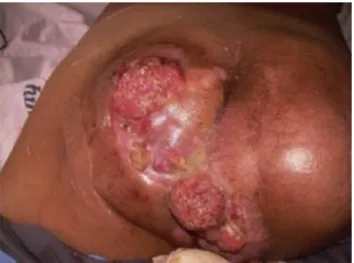jcoloproctol(rioj).2014;34(3):185–188
Journal
of
Coloproctology
w w w . j c o l . o r g . b r
Case
report
Mucinous
adenocarcinoma
arising
from
recurrent
perianal
fistula
in
patient
with
Crohn’s
disease:
case
report
夽
Suelene
Suassuna
Silvestre
de
Alencar
a,b,c,d,∗,
Romualdo
da
Silva
Corrêa
a,b,d,e,
Cátia
de
Franc¸a
Bezerra
a,f,
Marcelo
José
Carlos
Alencar
a,d,g,
Cristiana
Soares
Nunes
a,d,g,
Davi
Aragão
Alves
da
Costa
a,d,f,
Emanuela
Simone
Cunha
de
Menezes
a,d,h,
Antonio
Luiz
do
Nascimento
a,d aHospitalUniversitárioOnofreLopes,UniversidadeFederaldoRioGrandedoNorte(UFRN),Natal,RN,BrazilbSociedadeBrasileiradeColoproctologia,Brazil
cUniversidadeFederaldePernambuco(UFPE),Recife,PE,Brazil
dUniversidadeFederaldoRioGrandedoNorte,Natal,RN,Brazil
eUniversidadeFederaldeSãoPaulo(UNIFESP),SãoPaulo,SP,Brazil
fLigaNorteRiograndenseContraoCâncer,Natal,RN,Brazil
gComplexoHospitalarMonsenhorWalfredoGurgel,Natal,RN,Brazil
hHospitalEduardoMenezes,BeloHorizonte,MG,Brazil
a
r
t
i
c
l
e
i
n
f
o
Articlehistory:
Received11April2014
Accepted15May2014
Availableonline2July2014
Keywords:
Mucinousadenocarcinoma
Crohn’sdisease
Analfistula
Localrecurrenceofneoplasia
Colectomy
a
b
s
t
r
a
c
t
Introduction:Analcarcinomaisararevariantofepithelialtumorsoftheanalcanal.When
associatedwithchronicandactiveanalfistulas,usuallythisisanaggressivecancerthathas
difficultdiagnosisandpoorprognosis.AnalfistulasareacommonmanifestationofCrohn’s
disease(CD).Thisstudyaimstoreportacaseofmucinousadenocarcinomaoriginatingfrom
recurrentperianalfistulainpatientswithCD.
Casereport:Amanof43years,withmelanoderma,complainingofperianaltumors,anal
pain andmucopurulentsecretion,thepatientwasdiagnosedwithfistulae.Colonoscopy
revealed a chronicinflammatoryprocessassociatedwith villouspolypoidlesion inthe
colonic andrectalmucosa.Inanewepisode,whereitwasdiagnosed,chroniccolitisof
rectumandsigmoidwasbeing prescribedsulfasalazinewithimprovement.Therewere
relapsesandthepatientunderwentrepeatedfistulectomias.Afterinvestigation,CDwas
diagnosed.Computedtomography(CT)ofabdomenandpelvisshowedmultipleperinealand
glutealcollections,andthepatientunderwentabdominoperinealresectionoftherectum.
Anatomopathologicalexamshowedinvasivemucinousadenocarcinoma.AnewCTshowed
夽
StudylinkedtotheDepartmentofIntegratedMedicine,UniversidadeFederaldoRioGrandedoNorte(UFRN),Natal,RN,Brazil.
∗ Correspondingauthor.
E-mail:suelene@ufrnet.br,suelenesuassuna@gmail.com(S.S.S.deAlencar).
http://dx.doi.org/10.1016/j.jcol.2014.05.007
186
jcoloproctol(rioj).2014;34(3):185–188residualgrowthofthelesion.Thepatientwasreferredtotheoncologyreferralservice,
wherechemotherapyandradiotherapywereplanned.Thepatientdevelopedunfavorably,
andhisdeathoccurredtwomonthsaftertreatment.
©2014SociedadeBrasileiradeColoproctologia.PublishedbyElsevierEditoraLtda.All
rightsreserved.
Adenocarcinoma
mucinoso
surgindo
de
fístula
perianal
recidivante
de
paciente
com
doenc¸a
de
Crohn:
relato
de
caso
Palavras-chave:
Adenocarcinomamucinoso
Doenc¸adeCrohn
Fístulaanal
Recidivalocaldeneoplasia
Colectomia
r
e
s
u
m
o
Introduc¸ão: Carcinomaanaléumararavariantedetumoresepiteliaisdocanalanal.Quando
associadoafístulasanaiscrônicaseativas,geralmenteéumcânceragressivoque
pos-suidifícildiagnósticoemauprognóstico.Fístulasanaissãoumamanifestac¸ãocomumda
doenc¸adeCrohn(DC).Esteestudotemcomoobjetivorelatarumcasodeadenocarcinoma
mucinosooriginadodefístulaperianalrecidivanteempacientecomDC.
Relatodecaso: Homemde43anos,commelanodermaequeixasdetumorac¸õesnaregião
perianal,doranalesecrec¸ãomucopurulenta,sendodiagnosticadafístula.Acolonoscopia
evidenciouprocessoinflamatóriocrônicoassociadoàlesãopolipóidevilosaemmucosa
colônicaeretal.Emumnovoepisódio,constatou-secolitecrônicaemretoesigmóide,sendo
prescritosulfassalazinacommelhora.Houverecidivadoquadroeopacientefoisubmetido
arepetidasfistulectomias.Apósinvestigac¸ão,diagnosticou-seDC.Atomografia
computa-dorizada(TC)deabdomeepelvedemonstroumúltiplascolec¸õesperineaiseglúteas,tendo
sido realizada ressecc¸ão abdominoperineal doreto. O exame anátomo-patológico
evi-denciouadenocarcinomamucinosoinvasivo.NovaTCdemonstroucrescimentodalesão
residual.Noservic¸odereferênciaoncológica,foramplanejadasquimioterapiae
radiote-rapia.Opacienteevoluiudesfavoravelmenteeveioaóbitoapósdoismesesdotratamento.
©2014SociedadeBrasileiradeColoproctologia.PublicadoporElsevierEditoraLtda.
Todososdireitosreservados.
Introduction
Analcarcinomaisararevariantofepithelialtumorsofanal
canal.1 Mucinousadenocarcinoma correspondsto3–20%of
all anal carcinomas.1–3 When associatedwith chronic and
active anal fistulae, generally this is an aggressive cancer
thathasaverydifficultandpoorprognosis.1,3 Analfistulae
areacommonmanifestationofCrohn’sdisease(CD),being
presentin54%ofcases.4,5Theirmalignancyprocesswasfirst
describedin1974byLightdaleandsubsequentlyhadits
inci-dencedemonstratedin0.7%ofpatientswithCD.3,5
Here,wedescribeacaseofmucinousadenocarcinoma
orig-inatedfromrecurrentperianalfistulainapatientwithCD.
Case
report
43-Year-old man with melanoderm was admitted in May
2009with complaints ofperianal tumors forfour months.
Describedepisodesofanalpainandmucopurulenceforabout
11years,withadiagnosisoffistula,nottreatedatthattime.A
colonoscopywasperformedinMay2002,revealingachronic
inflammatoryprocessassociatedwithvillouspolypoidlesion
withmilddysplasiaincolonicand rectalmucosa.Inanew
episode,chroniccolitiswithanongoinginflammatoryprocess
intherectumandsigmoidwasobserved;sulfasalazinewas
prescribed.Afteranasymptomaticyear,therewasrecurrence
ofsymptomsandthepatientunderwentrepeated
fistulecto-mias. In2006,afterendoscopicand pathologicstudies,the
patientwasdiagnosedwithCrohn’sdisease.After1year,a
treatmentwithciprofloxacinandinfliximabwasstarted,with
favorableevolution.Inthefollowingyear,thecondition
wors-enedandthepatientwasreferredandadmittedtoourservice.
Thepatientreportedweightlossof23kg(27%)sincethe
beginningofthedisease,tobaccouse(7packs/year;stopped
smokingeightmonthsago)andalcoholconsumptionfor22
years. During physical examination, on palpation revealed
painintherightiliacfossa,presenceoftumorsintheperianal
region (thelargest withabout15cm)withareas of
mucop-urulentdischargeandacharacteristicodor,associatedwith
anal fistulasand vegetating, friable lesions(Fig.1). A
com-puted tomography(CT)oftheabdomen andpelvisshowed
multipleperinealandglutealcollections(Fig.2).Thepatient
underwent abdominoperineal resection of the rectum and
exenterationofsoftparts,whenaninvasivepelvicinjurywith
incompleteresectionwasverified.Thepathologicanalysisof
the surgicalspecimendiagnosedinvasivemucinous
adeno-carcinoma. A new CT in latepostoperative period showed
growth ofresidualinjuryand extensivesofttissue
involve-mentofbothglutealregions,formingalargeheterogeneous
jcoloproctol(rioj).2014;34(3):185–188
187
Fig.1–Perianaltumorswithareasofmucopurulent dischargeandacharacteristicodor,associatedwithanal fistulasandvegetating,friablelesions.
Fig.2–Computedtomography(CT)oftheabdomenand pelvisshowingmultipleperinealandglutealcollections.
theoncologyreferralcenter,wherechemotherapyand
radio-therapywere planned.However,withthe worseningofthe
clinicalcondition,theplannedtreatmentwasdiscontinued.
Thecasedevelopedunfavorablyandthepatientdiedaftertwo
monthsoftreatment.
Discussion
Overthepast60years,only61casesofmucinous
adenocar-cinomaoriginated in ananorectal fistulainDC have been
Fig.3–Growthofresiduallesion,forminglarge heterogeneousmassesintheglutealregion.
publishedintheliterature.Amongthepatientspresented,61%
werewomen.Ingeneral,inmales,thediagnosisofthis
dis-easeislatelyestablishedandittakeslongerfortheevolution
ofDCtothedevelopmentofmalignancy.Theaverageageat
diagnosisis50years,after20yearsofDCevolution.5,6
Althoughseveralhypotheseshavebeenputforwardforthe
emergenceofadenocarcinomaasacomplicationofCD,there
isnoconsensusyetastoitstrueetiology.Somepossible
expla-nationssuggestthecontinuousregenerationofthemucosain
chronicfistulasasareasonforthemalignantdegeneration.
Another hypothesis would be the long-term
immunosup-pressionasamechanismforcarcinogenesis.6Someauthors
consider the possibility that the malignancy process was
duetotheprolongeduseofmetronidazole,azathioprineand
immunobiologicals.7
Clinicallythepatientmaymanifestpainandrectal
bleed-ing, anal abscess, perianal mass and edema and chronic
discharge.1,2,8,9 Digital rectalexamination(DRE) may reveal
onlyahardenedareaadjacenttothefistula.10Furthermore,
thestenosisandanalpainmaylimitthephysicalexamination,
delayingthediagnosis.5
Uponpresentation,in80%ofcasesthetumorhasusually
morethan 5cm indiameter andmay presentinguinal and
retrorectalmetastasis.1Furthermore,thediagnosisof
muci-nousadenocarcinomaisdifficult,duetothepresenceofother
simultaneousconditionssuchasPaget’sdisease,leukoplakia,
hemorrhoidsandfissures.2
Endorectal ultrasonography, computed tomography (CT)
andmagneticresonanceimagingareteststhatcanassessthe
extentofthedisease.1,5 However,sometimesthesemethods
arenotveryuseful.5
Biopsiesofthefistuloustractandoftheabscessare
criti-caltoanearlydiagnosisandtreatment.11Athistopathological
examination,thistypeoftumorcontainscancerigenouscells
that produce largeamounts ofextracellular mucin, witha
mucinouscomponentinmorethan50%ofthetumorvolume,
whichcharacterizesthemucinousadenocarcinoma.12
In general, mucinous adenocarcinomashave a reserved
prognosis duetoa latediagnosis inmost cases,when the
188
jcoloproctol(rioj).2014;34(3):185–188goodprognosisafterabdominoperinealamputation,probably
duetothetendencyofthistumortobewelldifferentiated,by
itsslowgrowthandtherarityofmetastasestolymphnodes.11
Asforthetherapytobeinstituted,ithasbeenaccepted
that the presence ofdysplasia associated to the lesion or
mass in patients with CD is an indication for colectomy,
dueto the increasedriskof neoplasia.In general,there is
atendencytowardmoreradicalprocedureswhencolorectal
cancerisassociatedwithCrohn’sdisease.13Theroleof
radio-therapyinthetreatmentofperianalmucinouscarcinomais
notestablished,becausesomeauthorshypothesizethatthe
radiation can cause changes in the consistency of mucin,
inducingtumorgrowth.11,14However,itwasmentionedthat
a strict follow-up associated with adjuvant chemotherapy
and/orradiotherapycanpreventlocalrecurrence.11
Conclusion
Thisreport highlights the difficulty inthe management of
patientswithmucinousadenocarcinomaarisinginanal
fis-tulaassociatedwithCrohn’sdisease,emphasizingtheneed
foranearlydiagnosisforinstitutionofanaggressivetherapy,
aimedatamorefavorableprognosis.
Conflicts
of
interest
Theauthorsdeclarenoconflictsofinterest.
r
e
f
e
r
e
n
c
e
s
1. Ibá ˜nezJ,ErroJM,ArandaF,AlmendralML,ValentiC, Echenique-ElizondoM.Adenocarcinomamucinosoenfístula perianaldelargotiempodeevolucióntratadomediante QT-RTneoadyuvanteyamputaciónabdominoperineal laparoscópica.CirEsp.2006;79:184–5.
2. OngJ,Jit-FongL,Ming-HianK,Boon-SweeO,Kok-SunH,Eu KW.Perianalmucinousadenocarcinomaarisingfromchronic
anorectalfistulae:areviewfromasingleinstitution.Tech Coloproctol.2007;11:34–8.
3.IngleSB,LoftusJrEV.ThenaturalhistoryofperianalCrohn’s disease.DigLiverDis.2007;39:963–9.
4.LahatA,AssulinY,Beer-GabelM,ChowersY.Endoscopic ultrasoundforperianalCrohn’sdisease:diseaseandfistula characteristics,andimpactontherapy.JCrohnsColitis. 2012;6:311–6.
5.Ca ˜neteJ,PortillaF,JordánC,Sánchez-GilJM,PadilloFJ. Adenocarcinomamucinososobrefístulaanorrectalen pacienteconenfermedaddeCrohn.CirEsp.2012;90:336–8.
6.ThomasM,BienkowiskR,VandermeerTJ,TrostleD,CagirB. MalignanttransformationinperianalfistulasofCrohn’s disease:asystematicreviewofliterature.JGastrointestSurg. 2010;14:66–73.
7.FreemanHJ,PerryT,WebberDL,ChangSD,LohM-Y. MucinouscarcinomainCrohn’sdiseaseoriginatingina fistuloustract.WorldJGastrointestOncol.2010;2:307–10.
8.LeonR,RameshA,WilsonMS,O’DwyerST.Primaryand metastaticperinealadenocarcinoma:aetiologyand management.ColorectalDis.2006;8:814–6.
9.DiffaaA,SamlaniZ,ElbahlouliA,RabbaniK,NarjisY, ElamansouriF,etal.Primaryanalmucinousadenocarcinoma: acaseseries.ArabJGastroenterol.2011;12:48–50.
10.HamaY,MakitaK,YamanaT,DodanukiK.Mucinous adenocarcinomaarisingfromfistulainano:MRIfindings.AJR AmJRoentgenol.2006;187:517–21.
11.OkadaK-I,ShatariT,SasakiT,TamadaT,SuwaT,FuruuchiT. Ishistopathologicalevidencereallyessentialformakinga surgicaldecisionaboutmucinouscarcinomaarisingina perianalfistula?ReportofaCase.SurgToday.2008;38: 555–8.
12.CatalanoV,LoupakisF,GrazianoF,BisonniR,TorresiU, VincenziB.Prognosisofmucinoushistologyforpatientswith radicallyresectedstageIIandIIIcoloncancer.AnnOncol. 2012;23:135–41.
13.SvrcekM,CosnesJ,BeaugerieL,ParcR,BennisM,TiretE, etal.ColorectalneoplasiainCrohn’scolitis:aretrospective comparativestudywithulcerativecolitis.Histopathology. 2007;50:574–83.
